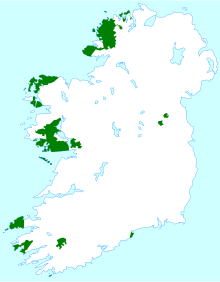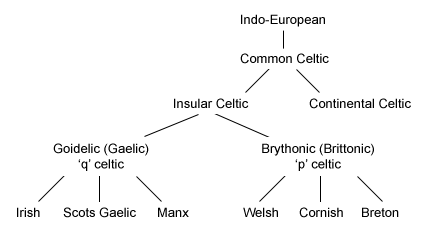Irish Language/History of the Irish Language
This page gives a brief overview of the history of the Irish language.
Ireland as a Celtic Language
[edit | edit source]The Irish language belongs to the family of Celtic languages. By the 5th century B.C., the Celtic tribes occupied much of Europe. The word "Celt" is derived from the Greek name for these tribes, "Keltoi" (meaning "secret people"). The Celtic languages evolved from Indo-European, which is the common ancestor of many of the languages in Europe and southern Asia.
The development of the Celtic languages is illustrated below. Eventually the forms of the Celtic languages spoken on the continent died out, leaving only the insular forms. At some point, the insular Celtic language divided into "q-Celtic" or Goidelic (from Goidel 'Gael'), which retained the original Indo-European q sound, and "p-Celtic" Brythonic (from Brython 'Briton'), which replaced the q sound with a p sound.
The modern Celtic languages are Irish, Scottish Gaelic, Manx, Welsh, Cornish, and Breton.
Periods of Irish History
[edit | edit source]The history of Irish may be divided into the following periods:
- Primitive Irish (? - C.E. 600)
- Old Irish (C.E. 600-900)
- Middle Irish (C.E. 900-1200)
- Early Modern Irish (C.E. 1200-1600)
- Modern Irish
Irish Today
[edit | edit source]
Today, English is the most widely spoken language in Ireland, and Irish is recognized as endangered by UNESCO. But Irish is still spoken as a daily language by around 60,000 people living in the 'Gaeltachtaí' or Irish-speaking areas of Ireland. According to the Irish census, over 1.5m people in Ireland can speak it and over 300,000 use it daily. Irish is also studied and spoken by Irish immigrants and their descendants in many countries. The 2000 US census returns included 25,870 U.S. residents who speak Irish at home.
Irish is a Celtic language with over 1,500 years of written history. It was an important religious language in the early middle ages because of the importance of Irish monks in learning and religion in Europe. It began a gradual decline around the 11th century with the Norman invasions, after which French and, later, English became the language of administration and politics in areas ruled as Anglo-Norman colonies.
The modern-day Republic of Ireland has taken steps to preserve and promote the Irish language. It is a required subject in Irish schools through the end of secondary education, and Irish signs are seen throughout the country, even in areas where few adults speak Irish in their everyday life.
In Northern Ireland, Irish is recognized as an official minority language and has some presence in public media and education. In recent years, a few small 'gaeltachtaí' have been established in the North.

